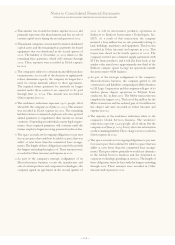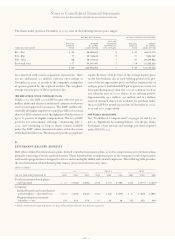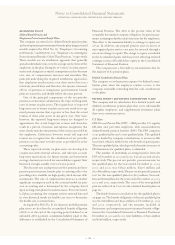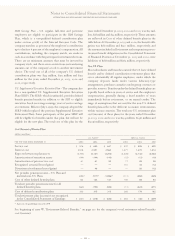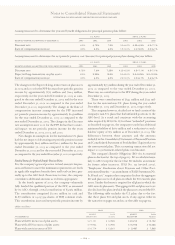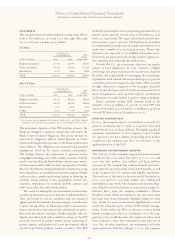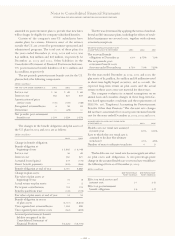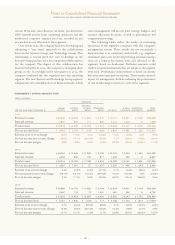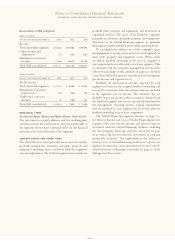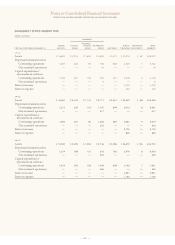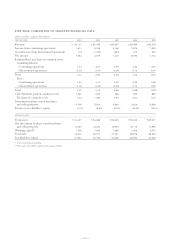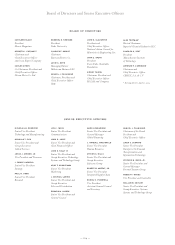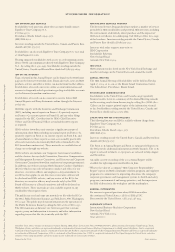IBM 2003 Annual Report Download - page 117
Download and view the complete annual report
Please find page 117 of the 2003 IBM annual report below. You can navigate through the pages in the report by either clicking on the pages listed below, or by using the keyword search tool below to find specific information within the annual report.
PLAN ASSETS
The company’s pension plan weighted-average asset alloca-
tions at December 31, 2003 and 2002 and target allocation
for 2004, by asset category, are as follows:
U.S. Plans
PLAN ASSETS
2004
AT DECEMBER 31:
TARGET
ASSET CATEGORY 2003 2002 ALLOCATION
Equity securities*67.5% 61.9% 65.0%
Debt securities 29.2% 34.5% 31,0%
Real estate 3.3% 3.6% 4.0%
Total 100.0% 100.0% 100.0%
Non-U.S. Plans
PLAN ASSETS
2004
AT DECEMBER 31:
TARGET
ASSET CATEGORY 2003 2002 ALLOCATION
Equity securities 59.1% 55.2% 58.2%
Debt securities 38.5% 40.9% 39.6%
Real estate 1.9% 2.2% 1.8%
Other 0.5% 1.7% 0.4%
Total 100.0% 100.0% 100.0%
*See discussion below regarding certain private market assets, and future funding
commitments thereof, that are not as liquid as the rest of the publicly traded securities.
The investment objectives of the PPP portfolio of assets (the
Fund) are designed to generate returns that will enable the
Fund to meet its future obligations. The precise amount for
which these obligations will be settled depends on future
events, including the life expectancy of the Plan’s members and
salary inflation. The obligations are estimated using actuarial
assumptions, based on the current economic environment.
The strategy balances the requirement to generate return,
using higher-returning assets such as equity securities, with the
need to control risk in the Fund with less volatile assets, such as
fixed income securities. Risks include, among others, the like-
lihood of the Plans becoming underfunded, thereby increasing
their dependence on contributions from the company. Within
each asset class, careful consideration is given to balancing the
portfolio among industry sectors, geographies, interest rate
sensitivity, dependence on economic growth, currency and
other factors that affect investment returns.
The assets are managed by professional investment firms
as well as by investment professionals who are IBM employees.
They are bound by precise mandates and are measured
against specific benchmarks. Among managers, consideration
is given, among others, to balancing security concentration,
issuer concentration, investment style, and reliance on partic-
ular active investment strategies. Market liquidity risks are
tightly controlled, with only a small percentage of the PPP
portfolio invested in private market assets consisting of
private equities and private real estate investments, which
are less liquid than publicly traded securities. The PPP
included private market assets comprising approximately 10.5
percent and 11.1 percent of total assets at December 31, 2003
and 2002, respectively. The target allocation for private mar-
ket assets in 2004 is 10.5 percent. The Fund has $2,465 million
in commitments for future private market investments to be
made over a number of years from plan assets. These com-
mitments are expected to be fulfilled from plan assets.
Derivatives are primarily used to hedge currency, adjust port-
folio duration, and reduce specific market risks.
Outside the U.S., the investment objectives are similar,
subject to local regulations. In some countries, a higher
percentage allocation to fixed income securities is required.
In others, the responsibility for managing the investments
typically lies with a board that may include up to 50 percent
of members elected by employees and retirees. This can result
in slight differences compared to the strategies described
above. Generally, these non-U. S. funds are not permitted to
invest in liquid assets, such as private equities, and their use
of derivatives is usually limited to passive currency hedging.
Equity securities include IBM common stock in the
amounts of $2,144 million (5.1 percent of total PPP plan
assets at December 31, 2003) and $2,006 million (5.4 percent
of total PPP plan assets at December 31, 2002).
EXPECTED CONTRIBUTIONS
In 2004, the company expects to contribute to its non-U.S.
plans in an amount that is equal to or greater than such
contributions in 2003 ($542 million). The legally mandated
minimum contributions to the company’s non-U.S. plans
are expected to be $220 million. Depending upon market
conditions, the company may elect to contribute to the
qualified portion of the PPP.
NONPENSION POSTRETIREMENT BENEFITS
The total cost of the company’s nonpension postretirement
benefits for the years ended December 31, 2003, 2002 and
2001, was $335 million, $353 million and $404 million,
respectively. The company has a defined benefit postretire-
ment plan that provides medical and dental benefits as well
as life insurance for U.S. retirees and eligible dependents.
The total cost of this plan for the years ended December 31,
2003, 2002 and 2001, was $294 million, $324 million and
$376 million, respectively. The changes in the benefit obliga-
tion and plan assets for this plan are presented on page 116.
Effective July 1, 1999, the company established a “Future
Health Account” (FHA) for employees who were more than
five years away from retirement eligibility. Employees who
were within five years of retirement eligibility are covered
under the company’s prior retiree health benefit arrange-
ments. Under either the FHA or the prior retirees health
benefit arrangements, there is a maximum cost to the com-
pany for retiree health benefits. For employees who retired
before January 1, 1992, that maximum became effective in
2001. For all other employees, the maximum is effective
upon retirement. Effective January 1, 2004, the company
Notes to Consolidated Financial Statements
INTERNATIONAL BUSINESS MACHINES CORPORATION AND SUBSIDIARY COMPANIES
115



